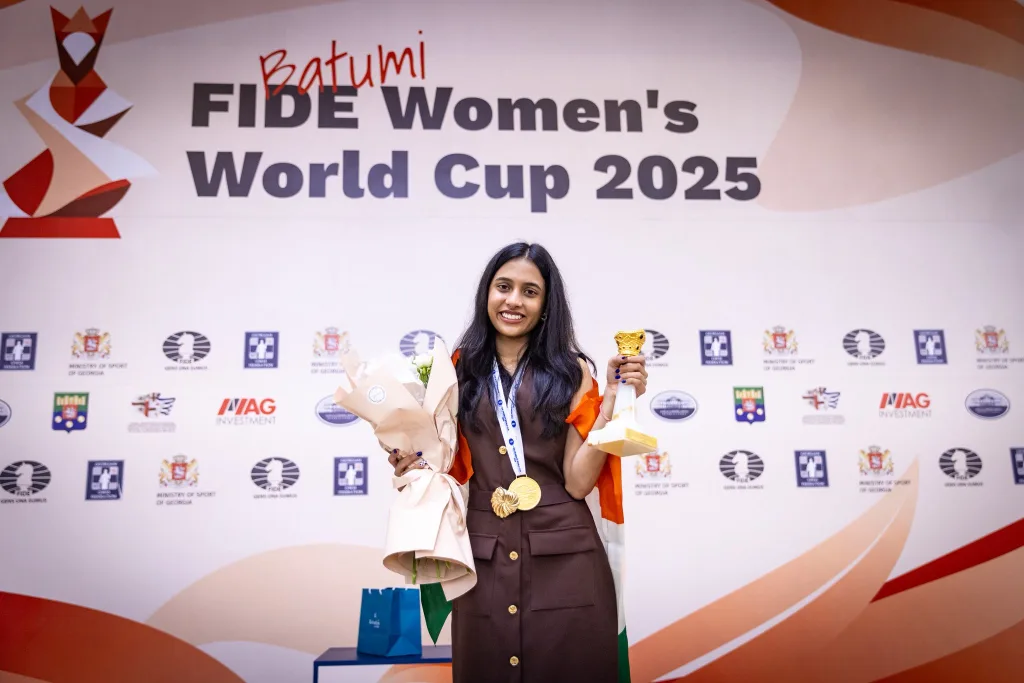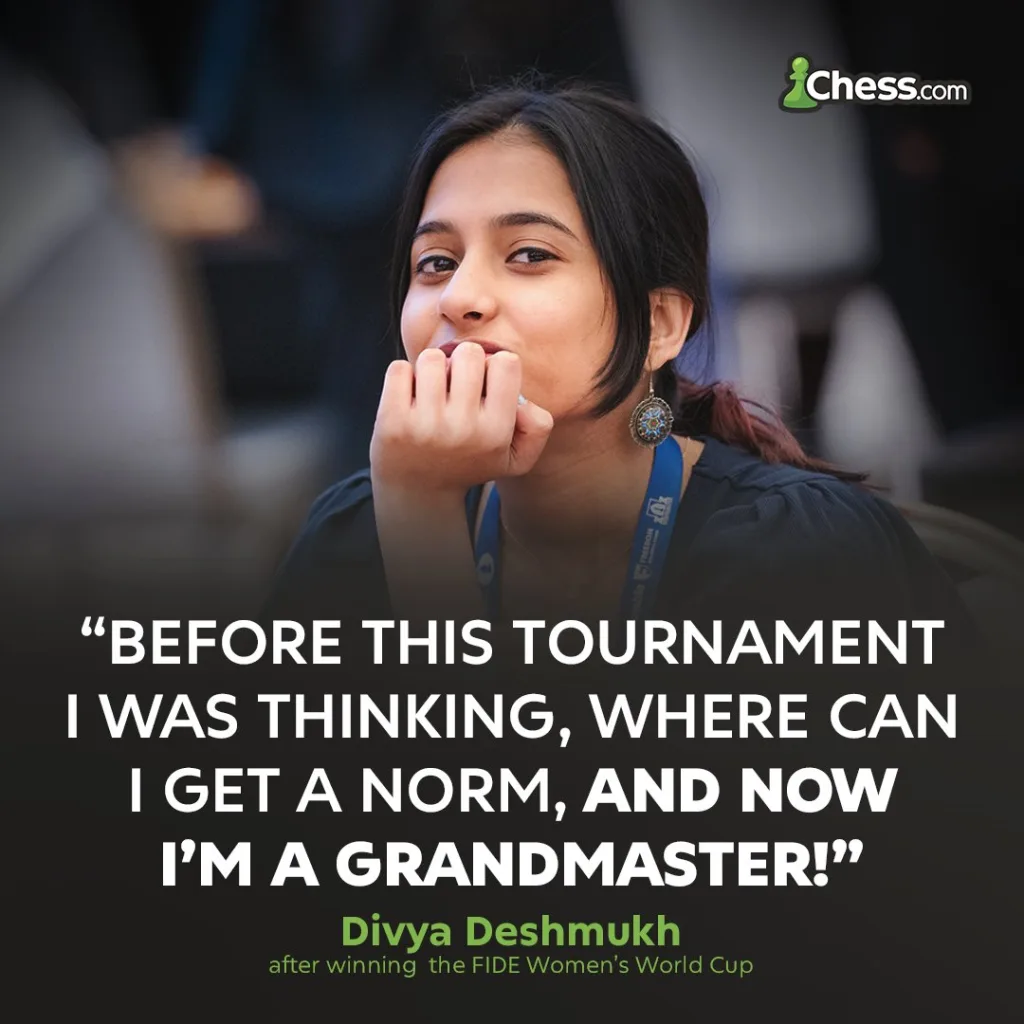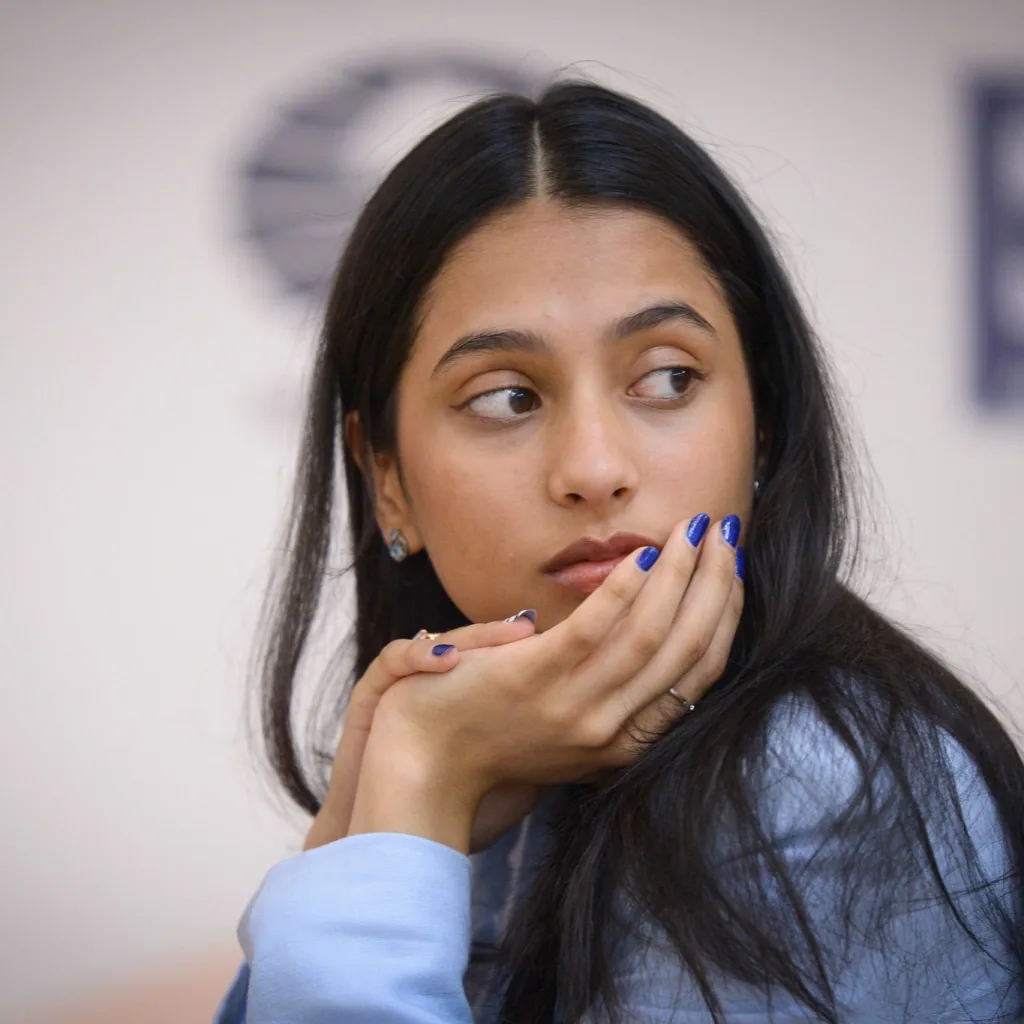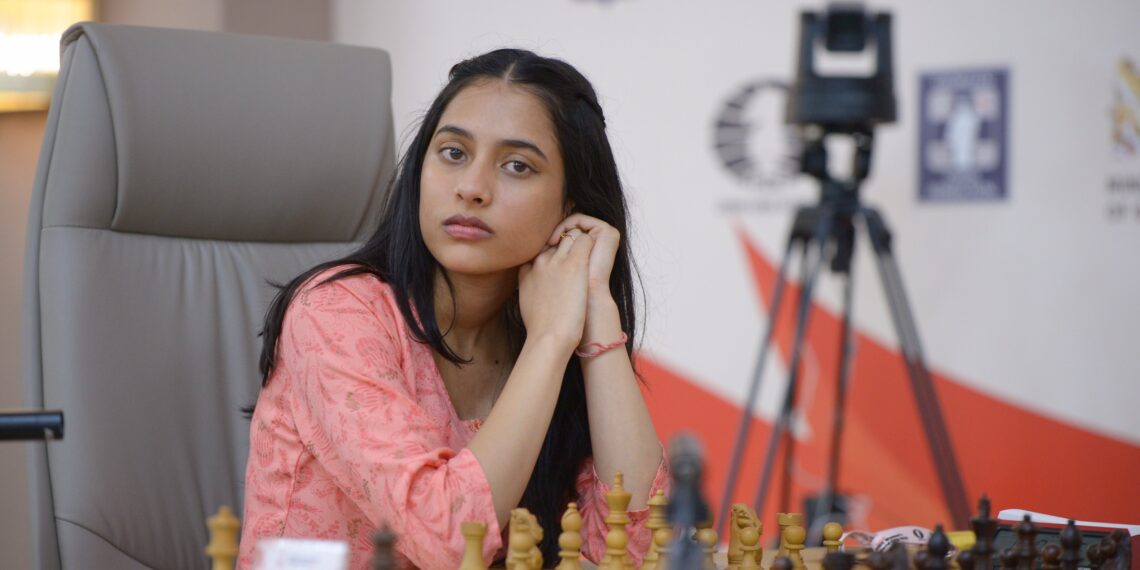In a spectacular display of nerves, skill, and determination, 19-year-old Divya Deshmukh has etched her name in chess history by becoming the youngest Indian player to claim the prestigious FIDE Women’s World Cup title.

Her victory over compatriot Humpy Koneru in a nail-biting tiebreak finale has not only brought glory to India but also earned her the coveted Grandmaster title in the most dramatic fashion possible.
Table of Contents
A Historic All-Indian Final That Captivated the Chess World
The 2025 FIDE Women’s World Cup reached its crescendo in Batumi, Georgia, where two of India’s finest chess talents faced off in an unprecedented all-Indian final. Divya Deshmukh, the young prodigy from Nagpur, Maharashtra, squared off against the experienced Grandmaster Humpy Koneru in what would become one of the most memorable finals in the tournament’s history.

After two classical games ended in draws, the championship was decided in rapid tiebreaks—a format that tests not only chess skill but also nerve and time management under extreme pressure. The tension was palpable as both players carried the hopes of a billion Indians and the weight of chess history on their shoulders.
The Decisive Tiebreak: A Tale of Nerves and Brilliance
Game One: A Missed Golden Opportunity
The first tiebreak game showcased the fighting spirit that had carried both players to the final. Divya, playing with the white pieces, opened with 1.e4, prompting Humpy to surprise everyone by choosing the Petroff Defense—a deviation from her usual repertoire that she had employed successfully against Divya in previous encounters.
The game followed theoretical lines until move 20, when Divya made the bold decision to play 20.d5, sacrificing her isolated queen’s pawn to activate her pieces. The position became tactically complex, with both players navigating intricate variations under time pressure.
The critical moment arrived when Humpy, with just 20 seconds remaining, played the unfortunate 33…Re7. Divya immediately seized the opportunity with 34.Rd1!, creating a devastating pin that forced Humpy to sacrifice her queen. Despite being down material, Humpy constructed a fortress that held the position together, and the game ended in a draw—but not before Divya had missed a winning opportunity on move 37.
Game Two: Championship Glory Through Chaos
The second tiebreak game began with Humpy choosing the Catalan Opening, a strategic choice that led to typical pawn structure imbalances. Divya responded with the aggressive 4…dxc4, 5…Bb4+ variation, accepting a pawn sacrifice for dynamic counterplay.
For nearly 40 moves, both players maneuvered carefully, with the position remaining balanced despite Divya holding an extra pawn. The game seemed destined for another draw until time pressure began to take its toll on the experienced Humpy.
In a moment that would define the championship, Humpy, with less than a minute on her clock, suddenly played 40.e4?!—a central break that shocked the commentary team. The follow-up 41.d5? proved to be the decisive error, allowing Divya to seize control with 41…Qe5!.
As five-time World Champion Viswanathan Anand observed during the live broadcast: “Humpy just collapsed and it was totally self-inflicted. There was no need for e4 and d5. This is just one of those situations where your nerves get the better of you and there’s nothing you can do.”
The game transitioned into a complex rook endgame where both players had chances, but ultimately, Divya’s superior time management and endgame technique proved decisive. After 69 moves of intense struggle, she emerged victorious, clinching the championship in the most dramatic fashion.
Breaking Barriers: More Than Just a Chess Victory
Divya Deshmukh’s triumph represents far more than a single tournament victory. At 19 years old, she has achieved multiple historic milestones:
Youngest FIDE Women’s World Cup Champion: Breaking age records while defeating seasoned grandmasters throughout the tournament.
Grandmaster Title Through Victory: Instead of the traditional path of earning three GM norms and achieving a 2500 rating, Divya earned her GM title by winning a major FIDE event—a rare and prestigious accomplishment.
India’s First Women’s World Cup Champion: Becoming the first Indian player, male or female, to win this prestigious title.
Fourth Indian Woman Grandmaster: Joining an elite group of Indian women who have achieved chess’s highest title.
The Path to Glory: A Tournament of Conquests
Divya’s journey to the championship was nothing short of spectacular. She defeated four established grandmasters en route to the title:
| Round | Opponent | Result | Significance |
|---|---|---|---|
| Round 4 | GM Zhu Jiner | Victory | Defeated Chinese talent |
| Quarterfinals | GM Harika Dronavalli | Tiebreak Victory | Beat fellow Indian |
| Semifinals | GM Tan Zhongyi | Victory | Former World Champion |
| Final | GM Humpy Koneru | Tiebreak Victory | Championship clincher |

Each victory showcased different aspects of her chess prowess—tactical acuity, endgame technique, psychological resilience, and the ability to perform under pressure.
Global Recognition and National Pride
The chess world took immediate notice of this historic achievement. Indian Prime Minister Narendra Modi congratulated Divya on social media, highlighting the significance of having two young Indian chess champions dominating the global stage—with 18-year-old Gukesh Dommaraju as the World Champion and now 19-year-old Divya as the Women’s World Cup winner.
The victory resonated beyond the chess community, inspiring millions of young Indians and demonstrating the country’s emerging dominance in international chess. Chess.com’s IM Rakesh Kulkarni captured the moment perfectly: “Indian teenagers are taking over the Chess World!”
Prize Money and Future Opportunities
Divya’s victory earned her the substantial first prize of $50,000, while runner-up Humpy Koneru received $35,000. However, the financial reward pales in comparison to the opportunities that lie ahead.
Most significantly, Divya has secured qualification for the 2026 FIDE Women’s Candidates Tournament, alongside Humpy Koneru and third-place finisher Tan Zhongyi. This prestigious event will determine the next challenger for the women’s world championship title, putting Divya within striking distance of chess’s ultimate prize.
Looking Ahead: A Champion’s Humble Ambitions
Despite her remarkable achievement, Divya remained characteristically humble in victory. “I need time to process it,” she said after the final game. “I think it was fate, me getting the grandmaster title this way, because before this I didn’t even have one norm and now I am a grandmaster.”
Her focus on continuous improvement was evident as she reflected on areas for development: “I definitely need to learn endgames. I’m pretty sure at some point I messed it up.” This self-awareness and commitment to growth suggest that this victory may indeed be, as she hopes, “just the start.”
The Tournament Format and Setting
The 2025 FIDE Women’s World Cup took place at the Grand Bellagio Hotel & Casino in Batumi, Georgia, from July 6-28. The tournament featured 107 players from 46 different federations in a single-elimination knockout format.
The time control consisted of 90 minutes for the first 40 moves, 30 minutes for the remainder of the game, plus a 30-second increment per move from the first move. Tiebreaks were played at faster time controls when classical games were drawn.
Tournament Statistics and Records
| Statistic | Details |
|---|---|
| Total Players | 107 from 46 federations |
| Tournament Duration | 23 days (July 6-28, 2025) |
| Venue | Grand Bellagio Hotel & Casino, Batumi, Georgia |
| Prize Fund | $300,000+ total |
| Champion’s Age | 19 years old |
| Final Score | Divya 1.5-0.5 Humpy (after tiebreaks) |
The Significance for Women’s Chess
Divya Deshmukh’s victory represents a generational shift in women’s chess. As the third-ever Women’s World Cup champion, following Alexandra Kosteniuk (2021) and Aleksandra Goryachkina (2023), she joins an exclusive club while simultaneously breaking new ground as the youngest winner in the tournament’s history.
Her success, combined with the strong showing of other young players throughout the tournament, suggests a bright future for women’s chess, with fresh talent challenging established hierarchies and pushing the game to new heights.

Divya Deshmukh’s victory at the 2025 FIDE Women’s World Cup is more than just another tournament win—it’s a statement that announces the arrival of a new chess superstar. Her combination of tactical brilliance, fighting spirit, and mental fortitude under pressure marks her as a player capable of achieving the highest honors in chess.
As she prepares for the Candidates Tournament and sets her sights on even greater achievements, the chess world watches with anticipation. If this victory is indeed “just the start,” as Divya hopes, then the future of women’s chess has never looked brighter.
The young champion from Nagpur has not only conquered the chess board but also captured hearts and imaginations worldwide. In doing so, she has proved that age is just a number when talent meets opportunity, and dreams are pursued with unwavering determination.
FAQs
What makes Divya Deshmukh’s FIDE Women’s World Cup victory so historic?
Divya Deshmukh became the youngest-ever FIDE Women’s World Cup champion at 19 years old, the first Indian player (male or female) to win this title, and earned her Grandmaster title through victory rather than the traditional norm system.
How did Divya Deshmukh defeat Humpy Koneru in the final?
After two classical games ended in draws, Divya won the rapid tiebreaks 1.5-0.5. She drew the first rapid game and won the second when Humpy made critical errors under time pressure with moves 40.e4 and 41.d5.
What prize money did Divya Deshmukh earn from winning the FIDE Women’s World Cup?
Divya earned $50,000 as the champion, while runner-up Humpy Koneru received $35,000. Additionally, she automatically qualified for the 2026 Women’s Candidates Tournament.
Which grandmasters did Divya Deshmukh defeat on her path to the FIDE Women’s World Cup title?
Divya defeated four grandmasters: GM Zhu Jiner (Round 4), GM Harika Dronavalli (Quarterfinals), GM Tan Zhongyi (Semifinals), and GM Humpy Koneru (Final).
What does Divya Deshmukh’s victory mean for the upcoming Women’s Candidates Tournament?
Her victory automatically qualifies her for the 2026 FIDE Women’s Candidates Tournament alongside Humpy Koneru and Tan Zhongyi, where she will compete for the right to challenge for the women’s world championship title.








